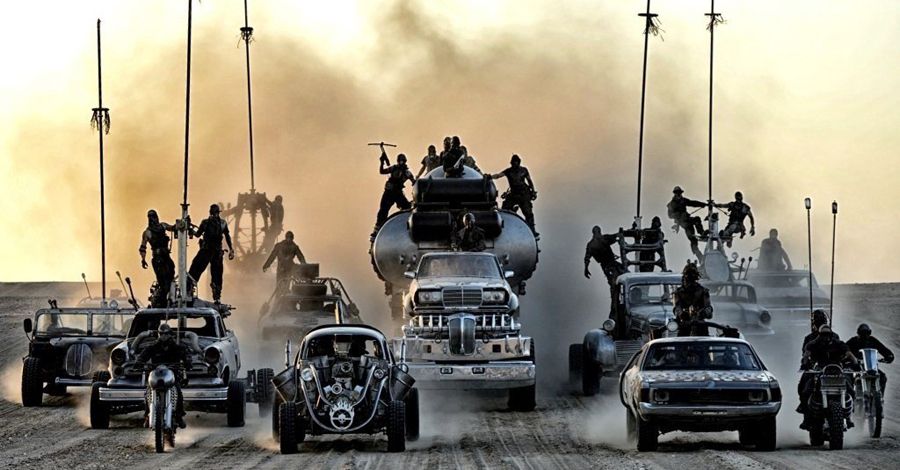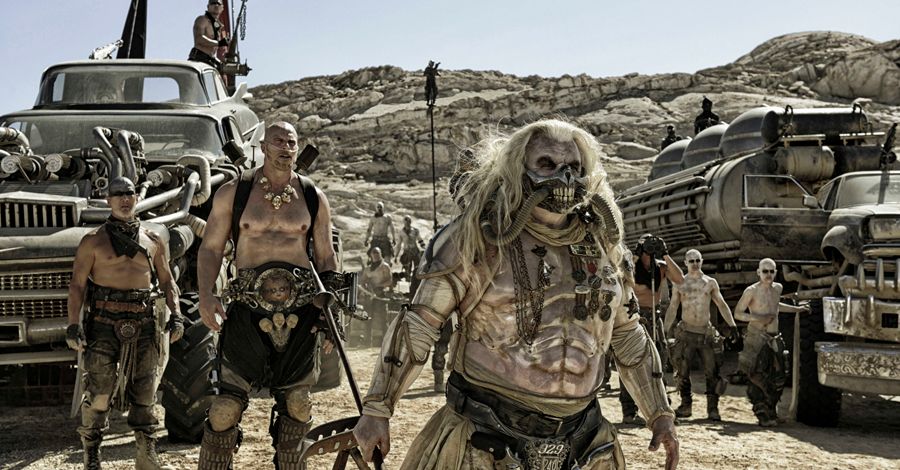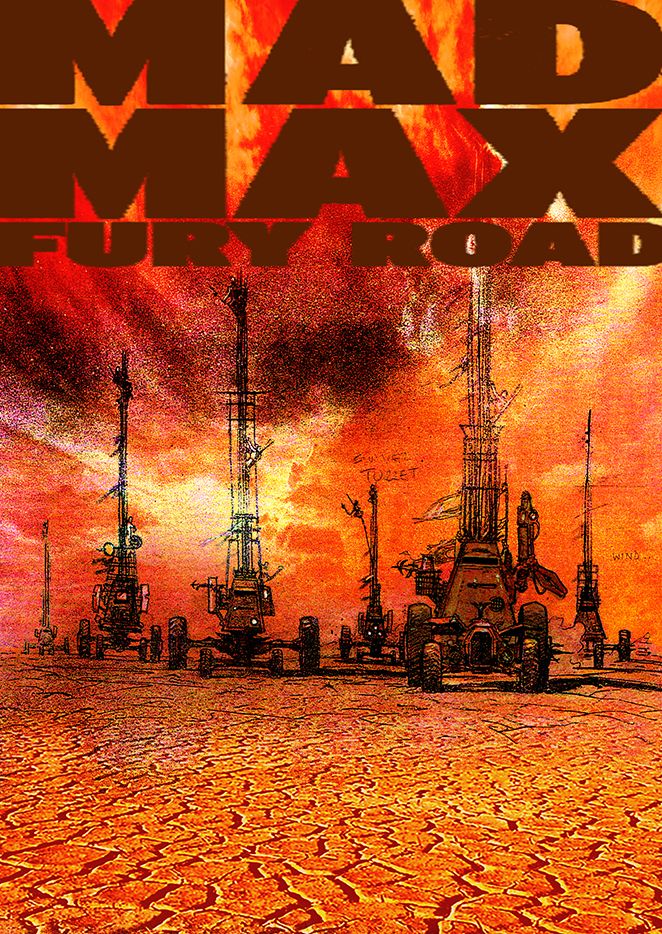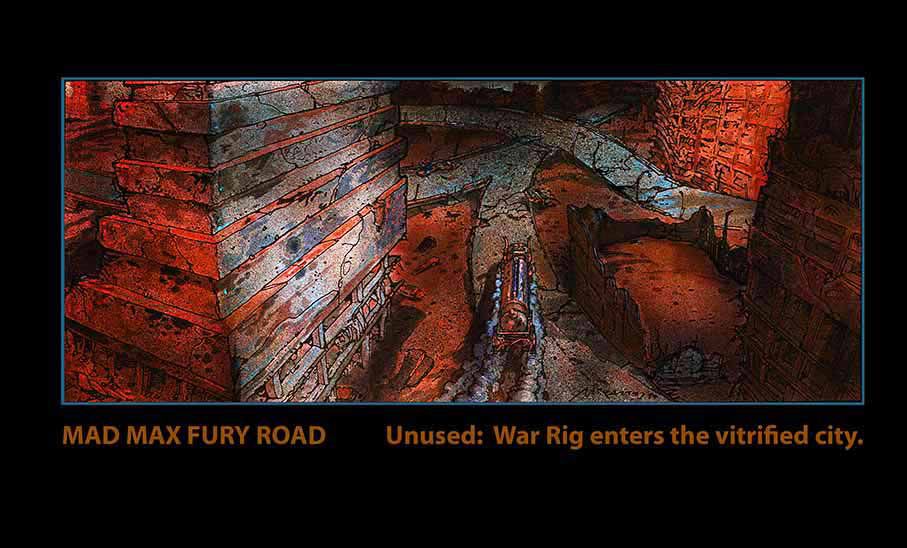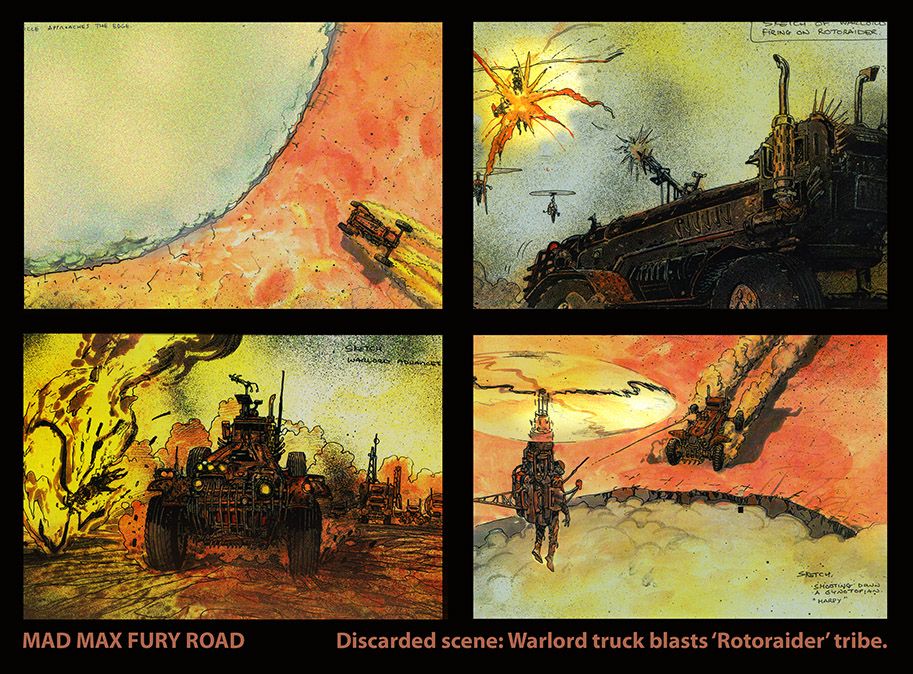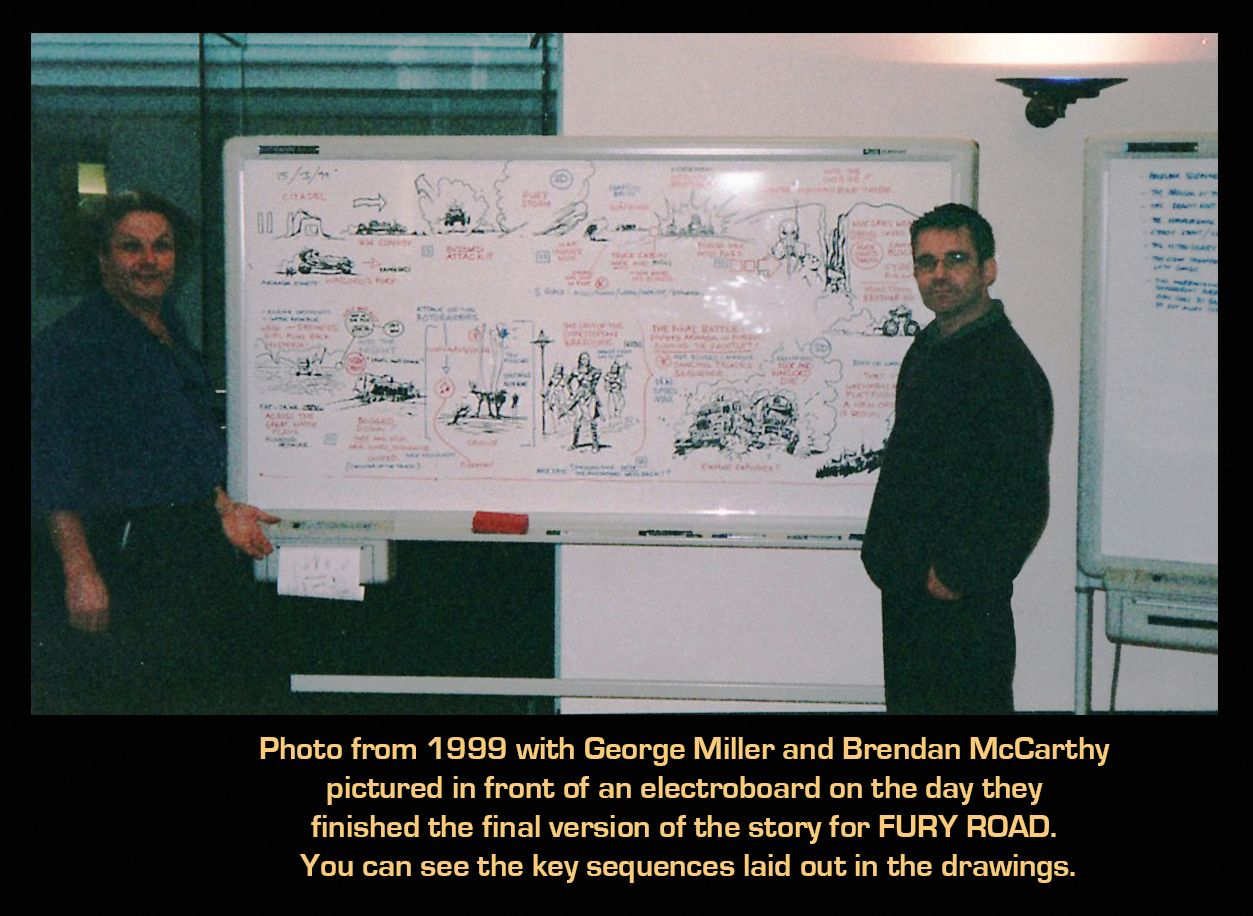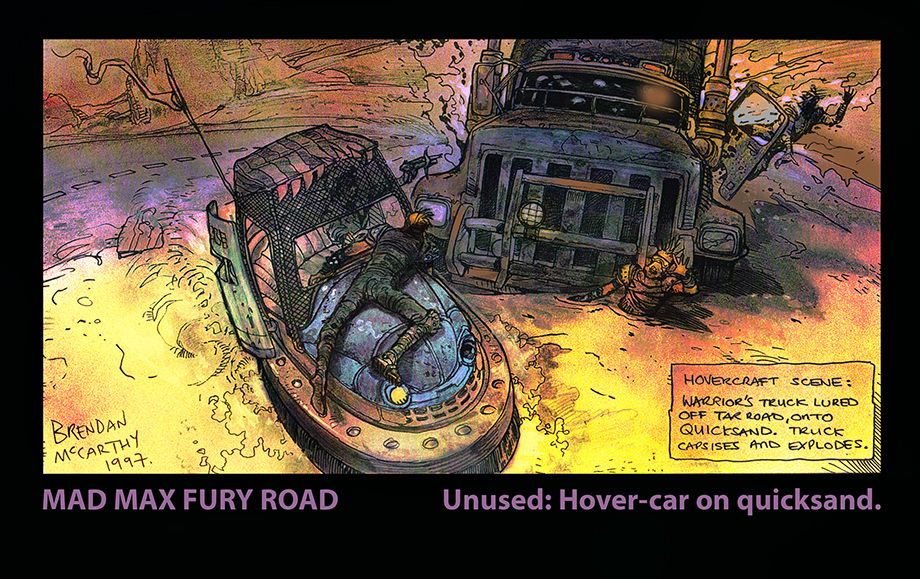Flame-throwing guitarists, white-faced warrior mutants and a post-apocalyptic BMX squad aren't found in ordinary Oscar contenders, but then again, "Mad Max: Fury Road" isn’t an ordinary film. The visually stunning feature, directed by George Miller and starring Tom Hardy and Charlize Theron, stormed the box office this summer and is now picking up a slew of honors, including best film by the National Board of Review and two Golden Globe nominations (Best Picture, Best Director).
RELATED: Brendan McCarthy Goes Full Throttle For ‘Mad Max: Fury Road’
Co-writer and concept designer Brendan McCarthy, long recognized as one of the United Kingdom’s most innovative comic creators, recently looked back on "Fury Road" for Spinoff Online, sharing behind-the-scenes commentary on his favorite scenes and characters, his hidden inspirations for the inhabitants of the wasteland, and sequences that didn’t make it into the final cut.
Spinoff Online: Brendan, let's start at the beginning with the already classic "Escape from the Citadel" action sequence in which Max and Furiosa first ride out onto the Fury Road. What are your thoughts on what some are already calling the greatest chase in film history?
Brendan McCarthy: I was very pleased with how the citadel was realized in the movie. The digital work was so good it didn't feel obviously “CGI,” if at all. It looked pretty realistic. It has the only piece of green in the movie -- an important story point for when later Max tells Furiosa and the others that the mythical “green place” that no longer exists is right where they came from. And that the new society that they want to build can be achieved there. But first, they have to take on the forces of the Warlord.
Speaking of the Warlord, could you give us insight into Immortan Joe and what went into creating him?
Possibly the greatest of the "Mad Max" villains. Frankly, I thought it would be very difficult to top the Humungus/Wez duo from "Road Warrior," but I feel that Immortan Joe had a greater emotional depth and almost felt like King Lear, raging out in the blasted wasteland, betrayed by his “daughters.” Joe represents the pinnacle of a corrupt patriarchy, and what better than to have somebody who sports a long flowing mane, his white hair based on the famous Michelangelo Sistine Chapel painting of God. Think of Zeus and Odin and all the white-haired “angry God” images that have defined Western religious and mythological culture. I was very impressed with the performance of actor Hugh Keays-Byrne. What he was able to convey with a mask covering half his face was really something special.
Worth noting for those who are aware of the surreal hotrod art of Big Daddy Roth, who created the famous designs of monsters at the wheel of jacked-up, souped-up hotrods. There are shots of Immortan Joe in the movie driving his monster Gigahorse vehicle that echo Roth's brilliant vision.
The film's primary narrative is a hunt for Immortan Joe's prized possessions -- The Five Wives. How did you develop them, as well as their savage savior Furiosa?
I spent a lot of time developing the characters of the girls, but Furiosa was George Miller's creation. One of the things that happened after the actors playing the “Wives” had been chosen was that they were workshopped together before the shoot, so that a kind of ease and “symbiotic” relationship between them would become intuitive. They would huddle together and sleep together in the back of the War Rig for days -- it had to feel like these women were brought up together, exclusively in their own company.
It was gratifying that, particularly on social media, the feminist allegory was picked up on so much. Although, in relation to the whole film, it became somewhat overstated. But they were the central characters, so their story and fate was to the forefront. The wretched existence of the War Boys in comparison -- young men propagandized into dying for false beliefs propagated by a god-like tyrant -- was another critique of our society that curiously, wasn't so remarked upon.
Immortan Joe wasn't the only antagonist -- the visually stunning Tribes of the Fury Road next joined him in his crusade.
When we were first putting the movie together we realized we had to have a few 'set piece' tribes that they would encounter driving on the "Fury Road." I invented the spiky scavengers, which we called 'Buzzards' due to their buzz saws for quick takedown of their prey. The Buzzard attack sequence was reminiscent of wildlife footage of packs of vicious hyenas attacking a lumbering wildebeest in the desert.
In the middle of writing the movie, I took a short break to a beach town on the Australian coast, Byron Bay. I wandered into a surfer's pub which had a big screen playing videos of track bikers doing incredible stunts. That's what gave me the idea for the canyon tribe, who leap over Furiosa's truck. George loved the high-flying action dynamics inherent in the idea and we worked a great deal on that sequence. They came out very well, I thought, and those action bike scenes were one of the highlights of the movie.
Immortan Joe's Armada was another feature that we put heaps of work into. I had wanted to evolve the movie's look on the cars beyond the “dune buggy” style of the previous trilogy, and hotrods seemed to be such an obvious way to go. I was surprised that style of vehicle hadn't been a part of the movies so far. The designs, mainly by Aussie artist Peter Pound were really great. He pretty much nailed the look, as he was the resident “petrol head” amongst us.
I created the “Polecats” with George Miller, who had an idea for warriors swinging on poles. I put them onto moving vehicles as kind of pirate boarders. Again, this allowed for a new kind of action dynamic, to counterpoint the ground level mayhem. I think they stole the show in a way -- those sequences were mainly boarded by Mark Sexton, a brilliant Aussie board artist, who also did a lot of the "Mad Max" comic series for Vertigo.
"Fury Road" is stuffed with enough visual inventiveness and mind-blowing action set pieces to fill a dozen Vin Diesel vehicles. Were there any sequences that had to be cut?
At one point we were considering that the sequence with the “Rockriders” in the canyon may have taken place in a ruined city, in a canyon of buildings. We played around with the idea for a while, but in the end, the story needed the canyon to be blocked by rocks, so we went with a natural rock formation as a better solution. Bringing to mind the horse disappearing into the sand in "Beyond Thunderdome," I played with the idea of a “quicksand sequence,” but it didn't fit into the flow of the story and was replicating the boggy swamp. So we ditched it!
The Vuvalini were once considered as a “flying tribe,” with helicopter and gyrocopter contraptions. So there was an aerial battle we messed around with where Immortan Joe, the Warlord, takes them down with harpoons. They were meant to be like the Harpies, from Greek mythology, vengeful females. Again, it didn't fit the flow of the story, so it got the elbow.
What was it like writing the film's screenplay with George Miller?
It was more like making a record. I was always put off by writing a full script because I thought it would mean sitting on my own in a room tapping away on a typewriter. But we did the whole thing standing up, pacing around and writing on a giant whiteboard, drawing mad stuff as we went along. It was like a band jamming and riffing, except it involved writing snippets of dialogue and designing the film as we went along. A lot of good laughs were had, I can assure you. It was a lot of fun -- which it needed to be to create such a outpouring of creativity. We came up with heaps of stuff that never made it into the final movie. There were so many crazy ideas and concept sketches done in those early years before the story really locked down and the discarding and editing process began. Which I think created a great deal of the internal richness of the film.
Judging by the staggering amount of Furiosas and Maxes seen at Halloween parties, it's clear that "Fury Road" has made a huge cultural impact this year. What do you feel the film's long-term legacy will be?
I certainly think that the movie has become an instant classic, to be put into the same company as the first two "Alien" movies, the Cameron "Terminator" films, "Blade Runner," "Empire Strikes Back," "The Matrix" and, of course, "Road Warrior." It's been gratifying to see how much the movie has penetrated the wider culture, from social media to Conan O'Brien TV skits. It really had a big impact. It's quite peculiar for me to meet younger fans of the film who had never seen the earlier Mel Gibson trilogy. I direct them to "Road Warrior" straightaway, so they can understand the roots of "Fury Road."
I feel that we equaled and in some ways bettered "Mad Max 2: Road Warrior," which for me personally, was a huge artistic achievement. George Miller has rightfully taken his place as one of the world's great directors, and I'm very pleased that both he and the film have been receiving great recognition. It's richly deserved.
"Fury Road" has already landed on many critics' best-of lists and is racking up awards left and right. Do you believe it could be headed toward Oscar glory?
I think it would be really great if George got a Best Director nomination at the Oscars -- and the movie itself was in the running for Best Picture. I think it's settling into being considered one of the most innovative and substantive action pictures of all time. It feels like it's up there with the best of the top tier directors' work, like Stanley Kubrick.
It stands up to repeated viewings and like a great album or piece of art, reveals more and more of itself. I'm very proud to have been in on the ground floor to co-write and design such a wonderful movie. Films like this show the world that comics creators are in the league of the very best.
RELATED: McCarthy Details Long Drive to "Mad Max: Fury Road" and "Dream Gang"
While "Fury Road" was your highest-profile work this year, I can't imagine Brendan McCarthy staying idle for long. What else have you been up to?
I've just put to bed the comic series "Dream Gang" for Dark Horse. It'll be coming out as a graphic novel collection in July. I'm currently doing some art and script revisions and putting together the “extras” for the GN. I have heaps of sketches and earlier versions of the story, so readers can see the evolution of the ideas. The "Dream Gang" are a group of nocturnal explorers who can access dream worlds, nightmares and fantasies. They uncover a dark plot to spread a destructive meme that will replicate itself into the minds of the sleeping population of the planet and drive humanity insane -- an invasion from within.
Recently, I did a talk on writing "Mad Max: Fury Road" with director/writer George Miller and Nico Lathouris, the other co-writer, in Australia. It was filmed and just been released online by the good folks from the GRAPHIC festival, a really wonderful comics/animation event they hold annually at the Sydney Opera House.
More of Brendan McCarthy's "Mad Max: Fury Road" designs can be viewed at his new website, artbrendan.com.

